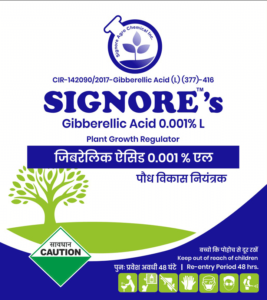Have you ever wondered how some plants seem to thrive effortlessly, reaching impressive heights and producing abundant fruit? The secret often lies in the use of gibberellic acid 0.001 L, a powerful plant hormone that plays a pivotal role in growth and development.
In the world of agriculture, understanding the benefits of plant growth regulators like gibberellic acid can transform the way we cultivate crops. From enhancing seed germination to boosting overall yield, this natural compound is a game changer.
As we delve into the topic of gibberellic acid uses in agriculture, you'll discover how it unlocks the potential of various crops, promoting healthier plants and better harvests. Join us on this journey to explore the fascinating applications and benefits of this remarkable substance.
In this article, we will uncover the transformative power of gibberellic acid uses in agriculture, revealing how it can elevate your farming practices and enhance crop productivity.
Table of Contents
ToggleChemical Composition of Gibberellic Acid
The chemical composition of gibberellic acid is defined by its formula, C19H22O6. This compound is a type of gibberellin, a plant hormone crucial for regulating growth and development.
Structure and Molecular Weight
Gibberellic acid has a molecular weight of 346.37 g/mol. Its structure includes a pentacyclic diterpene framework, which is essential for its biological activity in plants.
Functional Groups
The presence of hydroxyl groups in gibberellic acid contributes to its solubility and reactivity. These functional groups play a significant role in its interaction with plant tissues.
Natural Occurrence
Gibberellic acid is naturally produced by plants and fungi, particularly from the fungus Gibberella fujikuroi. This natural production highlights its importance in plant growth regulation.
Product name:
Chemical Composition:
| Gibberellic Acid a.i. – (Based on purity 100% a.i. w/w) | 0.001 % w/w |
| Protein – (hydrolysed) | 2.5 % w/w |
| Yeast Extract Seaweeds – (Marina Brown Algae Extract) | 3 % w/w |
| FeSO4 7H20 – (Min 95%) | 2.3 % w/w |
| MnSO4 3H20 – (Min 90%) | 1.4 % w/w |
| ZnSO4 7H20 – (Min 95%) | 3.9 % w/w |
| MgSO4 7H20 – (Min 90%) | 4.3 % w/w |
| EMULSIFIER Tween 80 – (Sorbital mono Oleate) | 1 w/w |
| Solvent – (Water) | Q.S % w/w |
Recommendations:
Mechanisms of Action
Cell Division and Elongation
One of the primary functions of gibberellic acid 0.001 L is to stimulate cell division and elongation. This process is crucial for the overall growth of plants, enabling them to reach their full potential.
When applied, gibberellic acid promotes the elongation of stem cells, leading to taller plants. This is particularly beneficial for crops like rice and wheat, where height can significantly impact yield.
How It Works
- Increases the production of enzymes that facilitate cell expansion.
- Enhances nutrient uptake, allowing for better growth conditions.
- Stimulates the synthesis of proteins that are critical for growth.
Seed Germination
Gibberellic acid also plays a vital role in seed germination. By breaking seed dormancy, it allows seeds to sprout more quickly and vigorously, which can be a game changer in farming.
This hormone triggers biochemical processes that lead to the activation of enzymes necessary for breaking down stored food in seeds. As a result, plants can emerge healthier and more robust.
Benefits for Seed Germination
- Increases germination rates significantly.
- Enhances seedling vigor, leading to stronger plants.
- Reduces time to maturity, allowing for earlier harvests.
Applications in Crop Production
Horticultural Crops
Gibberellic acid has significant applications in horticulture, particularly with fruits like grapes and citrus. Its ability to enhance growth and improve fruit quality makes it a valuable tool for growers.
For instance, in grape production, gibberellic acid is used to increase berry size and improve overall yield. This results in a more marketable product that can attract better prices.
Specific Applications in Horticulture
- Promotes larger fruit size and better flavor in grapes.
- Enhances fruit set and reduces premature fruit drop in citrus.
- Improves flowering and fruiting in various other horticultural crops.
Cereal Crops
The use of gibberellic acid extends to cereal crops, where it plays a crucial role in increasing productivity. Crops like rice and wheat benefit immensely from its application.
In particular, gibberellic acid helps in the development of dwarf varieties, which are more resistant to lodging and can produce higher yields under optimal conditions.
Benefits for Cereal Production
- Enhances stem elongation, leading to improved plant height.
- Increases grain filling and overall yield potential.
- Facilitates earlier maturity, allowing for timely harvesting.
How to Use Gibberellic Acid Spray on Crops?
Using gibberellic acid spray on crops can significantly enhance growth and yield. This plant growth regulator is effective for various applications, including improving seed germination and promoting flowering.
Application Timing
For optimal results, apply gibberellic acid during the cooler hours of the day. This helps to minimize evaporation and ensures better absorption by the plants.
Reapplication Guidelines
If rain occurs within six hours of spraying, a reapplication may be necessary to maintain effectiveness. Consistency is key to achieving the desired results.
Mixing and Dosage
Mix the recommended dosage of gibberellic acid with water before spraying. A common guideline is 250 ml of gibberellic acid per 200 liters of water per acre.
Uniform Coverage
Ensure that the spray covers the entire crop canopy uniformly. This thorough application helps maximize the benefits of gibberellic acid across all plants.
Target Crops
This versatile spray can be used on a variety of crops, including grains, vegetables, and fruits. Each type of crop may have specific guidelines for dosage and timing.
Benefits of Gibberellic Acid
Improving Crop Yield
Gibberellic acid is widely recognized for its ability to enhance crop yield across various agricultural settings. Farmers who incorporate gibberellic acid spray into their practices often see significant increases in production.
Research indicates that the application of gibberellic acid can lead to remarkable yield improvements, making it a vital component in modern farming techniques. This is particularly evident in cereal and horticultural crops.
Statistical Evidence
- Studies show yield increases of up to 20% in certain crops.
- Application timing can further optimize yield outcomes.
- Case studies demonstrate consistent results across diverse farming conditions.
Enhancing Quality
The benefits of gibberellic acid extend beyond just quantity; it also significantly improves the quality of crops. This is essential for farmers aiming to meet market demands.
By enhancing fruit size, flavor, and overall appearance, gibberellic acid helps farmers produce higher-quality products that can command better prices in the market.
Quality Improvements
- Increases fruit size and uniformity, making them more appealing.
- Enhances flavor profiles in fruits and vegetables.
- Promotes better shelf life and storage qualities for harvested crops.
How is Gibberellic Acid Made?
Gibberellic acid is primarily produced through fermentation processes using specific fungi, notably Gibberella fujikuroi. This method allows for the large-scale production of this essential plant hormone, crucial for various agricultural applications.
Fermentation Techniques
Two main fermentation techniques are used: solid-state fermentation (SSF) and submerged fermentation (SmF). SSF typically yields higher concentrations of gibberellic acid due to better nutrient availability and microbial activity.
Solid-State Fermentation
In SSF, substrates such as wheat bran or maize flour are inoculated with fungal spores. The fungi metabolize these substrates, producing gibberellic acid over several days of incubation.
Submerged Fermentation
In submerged fermentation, the fungi are grown in liquid media containing nutrients. This method allows for easier monitoring and control of environmental conditions but may yield lower concentrations compared to SSF.
Optimization Factors
Factors such as temperature, pH, and nutrient composition are critical for optimizing gibberellic acid production. Adjusting these parameters can significantly enhance yield and efficiency during fermentation.
Challenges and Considerations
Potential Risks
While gibberellic acid offers numerous benefits, it is essential to consider the potential risks associated with its use. Overapplication can lead to unintended consequences for plant health and the environment.
Farmers must be aware that excessive use may result in weak stems or delayed maturity, which can negatively impact crop quality and yield. Understanding proper application rates is crucial.
Common Risks
- Overgrowth leading to increased susceptibility to lodging.
- Pest and disease vulnerability due to rapid growth.
- Potential negative effects on soil health if used improperly.
Best Practices for Application
To maximize the benefits of gibberellic acid, farmers should follow best practices for its application. This ensures optimal results while minimizing risks associated with overuse.
Timing and method of application are critical factors that can influence the effectiveness of gibberellic acid. Proper planning can lead to healthier crops and improved yields.
Recommended Practices
- Apply during key growth stages for maximum impact.
- Use precise measurements to avoid overapplication.
- Monitor environmental conditions to ensure favorable outcomes.
Future Directions
Research Trends
The future of gibberellic acid in agriculture is bright, with ongoing research exploring new applications and formulations. Scientists are continually seeking ways to enhance its effectiveness and broaden its use across various crops.
Innovations in plant breeding programs are also underway, aiming to develop varieties that respond even better to gibberellic acid treatment. This could lead to more resilient and productive crops in the future.
Emerging Areas of Research
- Investigating synergistic effects with other plant growth regulators.
- Exploring the role of gibberellic acid in stress tolerance.
- Developing slow-release formulations for sustained effects.
Sustainable Agriculture
Gibberellic acid can play a significant role in promoting sustainable farming practices. By enhancing crop yield and quality, it helps farmers maximize productivity while minimizing resource use.
The integration of gibberellic acid into sustainable farming systems can lead to reduced reliance on chemical fertilizers and pesticides, contributing to healthier ecosystems and improved soil health.
Benefits for Sustainable Practices
- Supports organic farming initiatives by improving crop performance.
- Encourages efficient use of water and nutrients.
- Promotes biodiversity by enabling diverse cropping systems.
Frequently Asked Questions - FAQS
Q. How does gibberellic acid affect seed germination rates in wheat and barley?
A. Gibberellic acid significantly enhances seed germination rates in wheat and barley by breaking dormancy and promoting the synthesis of enzymes like amylase. This process mobilizes stored nutrients, ensuring robust seedling development and improved early growth vigor.
Q. What is the optimal application rate of gibberellic acid for increasing sugarcane yield in tropical climates?
A. The optimal application rate of gibberellic acid for sugarcane in tropical climates typically ranges from 100 to 200 ppm. This concentration effectively boosts growth, enhances sugar content, and increases overall yield when applied during critical growth stages.
Q. Can gibberellic acid be used to induce parthenocarpy in tomatoes grown in hydroponic systems?
A. Yes, gibberellic acid can induce parthenocarpy in hydroponically grown tomatoes, leading to fruit development without fertilization. This technique is beneficial for producing seedless fruits, enhancing marketability and consumer preference.
Q. How does gibberellic acid influence the flowering time of apples and pears in temperate regions?
A. In temperate regions, gibberellic acid influences flowering time by promoting bud break and accelerating the transition from vegetative to reproductive growth. This results in earlier flowering, which can enhance fruit set and yield potential.
Q. What are the potential side effects of using gibberellic acid on the environment and human health?
A. Potential side effects of gibberellic acid include disruption of local ecosystems if overused, as well as possible health risks from exposure during application. Careful handling and adherence to guidelines can mitigate these concerns.
Q. Is there a difference in the effectiveness of gibberellic acid when applied as a foliar spray or a soil drench?
A. Yes, the effectiveness of gibberellic acid can vary between foliar sprays and soil drenches. Foliar applications provide quicker results, while soil drenches may offer prolonged effects on root development and overall plant health.
Q. Can gibberellic acid be used to improve the shelf life of cut flowers like roses and lilies?
A. Gibberellic acid can enhance the shelf life of cut flowers such as roses and lilies by delaying senescence and promoting water uptake. This treatment helps maintain freshness and visual appeal for longer periods.
Q. How does gibberellic acid interact with other plant growth regulators, such as auxins and cytokinins?
A. Gibberellic acid interacts synergistically with auxins and cytokinins, enhancing growth responses such as cell elongation and division. These interactions are crucial for optimizing plant development and achieving desired agricultural outcomes.
Q. What are the best practices for storing and handling gibberellic acid to ensure its potency and safety?
A. To ensure potency, store gibberellic acid in a cool, dark place away from direct sunlight. Use protective gear during handling to minimize exposure risks, and adhere to manufacturer guidelines for safe usage.
Q. Can gibberellic acid be used to promote the growth of microgreens and edible sprouts?
A. Yes, gibberellic acid can effectively promote the growth of microgreens and edible sprouts by enhancing germination rates and improving overall vigor, resulting in healthier plants with better nutritional profiles.
Q. Is gibberellic acid effective in increasing the yield of strawberries grown in greenhouse conditions?
A. Gibberellic acid is effective in increasing strawberry yields in greenhouse conditions by promoting flowering, fruit set, and size enhancement, ultimately leading to higher marketable fruit production.
Q. How does gibberellic acid affect the quality of grapes used for winemaking?
A. The application of gibberellic acid improves grape quality for winemaking by enhancing berry size, sugar content, and flavor development, which are essential factors for producing high-quality wines.
Q. Can gibberellic acid be used to delay the senescence of lettuce and spinach?
A. Yes, gibberellic acid can delay senescence in lettuce and spinach by promoting leaf longevity and maintaining quality during storage, which is beneficial for extending shelf life post-harvest.
Q. What is the optimal timing for applying gibberellic acid to promote the growth of turfgrass?
A. The optimal timing for applying gibberellic acid on turfgrass is during active growth periods, typically in spring or early fall, to enhance establishment, density, and overall health of the grass.
Q. How does gibberellic acid influence the root development of plants?
A. Gibberellic acid positively influences root development by stimulating cell elongation and division within root tissues, leading to enhanced nutrient uptake capabilities and improved overall plant vigor.
Q. Can gibberellic acid be used to increase the size and weight of fruits like mangoes and avocados?
A. Yes, applying gibberellic acid can increase the size and weight of fruits such as mangoes and avocados by promoting cell expansion during critical growth phases, resulting in larger harvests.
Q. What are the potential risks of over-applying gibberellic acid to crops?
A. Over-applying gibberellic acid can lead to negative effects such as excessive vegetative growth, increased susceptibility to pests or diseases, and potential crop lodging due to weak stems.
Q. How does gibberellic acid affect the nutrient uptake of plants?
A. Gibberellic acid enhances nutrient uptake by stimulating root growth and improving root surface area, which allows plants to absorb more nutrients efficiently from the soil.
Q. Can gibberellic acid be used to induce flowering in plants that are normally short-day plants?
A. Yes, gibberellic acid can induce flowering in normally short-day plants by mimicking environmental cues that trigger reproductive development, thus allowing for more flexible growing conditions.
Q. What are the long-term effects of using gibberellic acid on soil health?
A. The long-term effects of using gibberellic acid on soil health include potential changes in microbial activity due to altered plant growth patterns; however, careful management practices can mitigate negative impacts.
Conclusion
Summary of Key Points
In summary, gibberellic acid is a powerful tool in agriculture, offering numerous benefits such as improved crop yield and enhanced quality. Its role in stimulating growth and development makes it invaluable for farmers worldwide.
From horticultural crops to cereals, the applications of gibberellic acid demonstrate its versatility and effectiveness in modern farming practices. Understanding its mechanisms can lead to better crop management strategies.
Farmers and agricultural professionals are encouraged to consider incorporating gibberellic acid into their crop management practices. With proper application and awareness of best practices, it can significantly enhance productivity and sustainability.
As we move towards more sustainable agricultural systems, embracing innovative solutions like gibberellic acid will be crucial in meeting the challenges of tomorrow's farming landscape.



